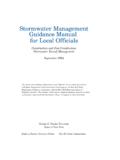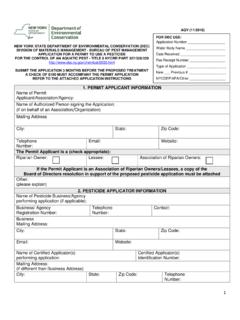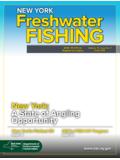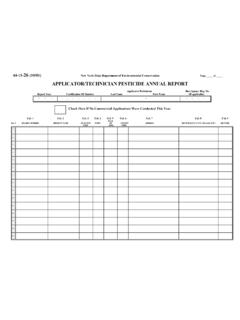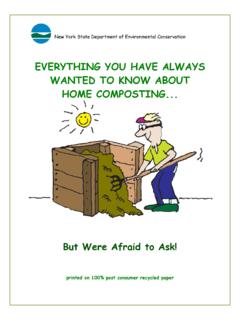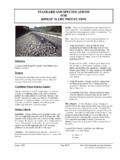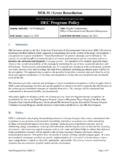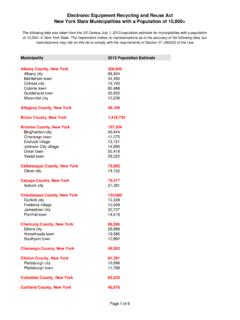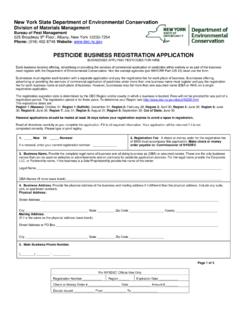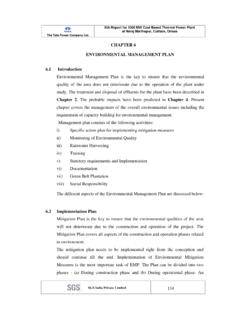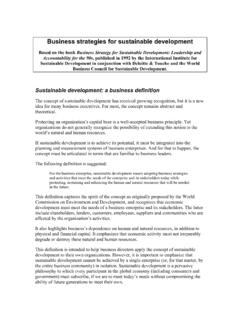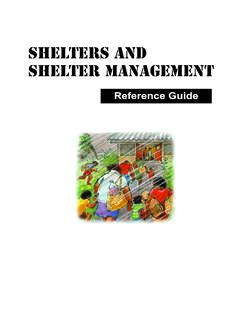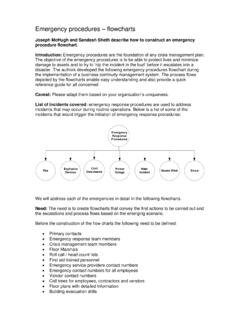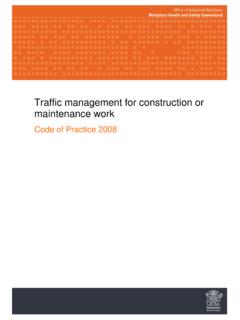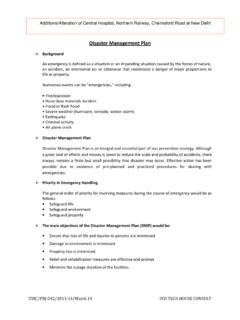Transcription of SECTION 4 EROSION CONTROL - PART 2 SOIL STABILIZATION …
1 SECTION 4 EROSION CONTROL - PART 2 SOIL STABILIZATION CONTENTS Page Scope and Discussion .. Principles of Biotechnical Practices .. Planning Considerations .. Plant Materials .. Anchored STABILIZATION Matting .. Armored Slope and Channel STABILIZATION .. Branch Packing .. Brush Layer .. Brush Mattress .. Fertilizer Application .. Fiber Roll .. Landgrading .. Lime Application .. Live Crib Wall .. Live Fascines .. Live Stakes .. Loose STABILIZATION Blankets .. Mulching .. Permanent construction Area Planting .. Recreation Area Seeding .. Retaining Walls .. Soil Restoration .. STABILIZATION With Sod .. Surface Roughening .. Temporary construction Area Seeding .. Topsoiling .. Tree Revetment .. Trees, Shrubs, and Vines .. Vegetated Rock Gabions.
2 Vegetating Sand and Gravel Borrow Areas .. Vegetating Sand Dunes and Tidal Banks .. Vegetating Waterways .. SECTION prepared by: Donald W. Lake Jr., PE, CPESC, CPSWQ Former State Conservation Engineer USDA Natural Resources Conservation Service Syracuse, New York Adjunct Assistant Professor State University of New York, College of Environmental Science and Forestry List of Tables and Figures Table Title Page Riprap Gradations .. Guide to Mulch Materials, Rates, and Uses .. Mulch Anchoring Guide.
3 Permanent Critical Area Planting Mixture Recommendations .. Recreation Turfgrass Seed Mixture .. Soil Restoration Requirements .. Topsoil Application Depth .. Size and Weight of Earth Ball Required to Transplant Wild Stock .. Vegetative Treatment Potential for Eroding Tidal Shorelines .. Maximum Permissible Velocities for Selected Seed Figure Title Page Angles of Repose of Riprap Stones .. Typical Riprap Slope Protection Detail .. Riprap Streambank Protection .. Channel STABILIZATION Methods.
4 Branch Packing .. Brush Layer .. Brush Mattress .. Fiber Roll .. Typical SECTION of Serrated Cut Slope .. Landgrading .. Landgrading - construction Specifications .. Live Cribwall .. Live Fascine .. Live Live Stake construction Specifications .. Typical Retaining Wall Examples .. Typical Segmented Retaining Wall Example .. Surface Roughening .. Tree Revetment .. Vegetated Rock Gabions .. Combination of Sand Fence and Vegetation for Dune Building .. Typical Cross- SECTION Created by a Combination of Sand Fence and Vegetation.
5 American Beachgrass Information Sheet .. Cordgrass Information Sheet .. Rill Maintenance Measures .. EROSION CONTROL - PART 2 SOIL STABILIZATION Scope and Discussion Soil STABILIZATION is the second step in controlling EROSION on a construction site or a disturbed area. EROSION is the gradual wearing away of the land surface as a result of uncontrolled wind and water energy. Sedimentation is the result of transport and delivery of eroded particles, deposited at some point. EROSION and sediment CONTROL is a complex interaction of soils, engineering water management, agronomic, and horticultural practices. Decisions for resolving EROSION conditions, both on the site and within the upper watershed, are formulated based on surface and subsurface water, soil material, climatic conditions, and anticipated land use.
6 Creating a stable slope is necessary prior to vegetating. Sloughing and slumping impede establishment of a uniform protective cover. Stabilizing onsite surfaces can be done with vegetation in the form of various seed mixes and mulch, land shaping, and using woody plants specifically selected for site specific applications, also known as a bio-technical STABILIZATION approach. General planning considerations for vegetating a steep slope will include evaluating the soil. Factors such as soil texture and steepness affect the stability of the slope. Texture also influences the permeability and water holding capacity of the soil. Many slopes are stripped of their topsoil during the construction phase, leaving an infertile, compacted soil surface, void of valuable organic matter. Topsoil must be reapplied. Overly compacted soil must be decompacted with appropriate equipment.
7 Soil pH and nutrient level are determined by obtaining a representative soil sample for analysis from an accredited lab. Appropriate plant material is designed and selected to meet the final slope and soil conditions for the site. These same concerns and practices also apply to flatter slopes and level areas. When specifying a fertilizer mix for an area, design the appropriate proportions to meet the nutrients needs for the specific site. Always apply as closely as possible the required amount of fertilizer to meet the needs for the site soils. Adding surplus nitrogen may cause pollution of drinking water and saltwater ecosystems. Excessive phosphorus may accelerate the aging process of freshwater ecosystems. Excessive amounts of Nitrogen (N) and Potassium Oxide (K2O) may result in burning the grass and killing it. All fertilizer applications will be in accordance with the Nutrient Runoff Law ECL Article 17, Title 21, January 1, 2012.
8 Principles of Biotechnical Practices The implementation of Biotechnical practices is the specialized use of woody plant materials to stabilize soil enhance structural practices, and provide added support to habitat. One of the factors that affects EROSION is vegetative cover. The more cover soil has, the more protected it is from the attacking forces of rainfall and runoff. Also working to hold the soil in place is the root mass that vegetation produces. Biotechnical measures generally combine basic engineering principles with plant science to create a system of stability and resource management for critical areas such as streambanks, roadside slopes, and large exposed areas. These systems may combine with structural measures to effect a strengthening of the soil structure and improve vegetative cover to resist surface EROSION . There are many advantages to Biotechnical practices: they are often less expensive to install they do not require specialized skills to install generally, heavy equipment is not required they are environmentally compatible since the design selects natural and native plant materials they provide a natural aesthetic appearance they provide wildlife habitat and cover and provide a food source to many land and aquatic species they mitigate thermal impacts to structural stream STABILIZATION practices such as rock riprap and retaining walls by providing shade they can be self repairing during and after stress On the other hand, there are some disadvantages to these measures.
9 Requires planning to obtain sources of plant materials higher risk due to less CONTROL with vegetation compared to structural practices require higher maintenance attention need an establishment period more sensitive to seasonal changes and seasonal New York State Standards and Specifications Page November 2016 For EROSION and Sediment CONTROL restrictions on planting may apply The use of Biotechnical practices is actually an old technology. These techniques have been practiced for centuries in Europe.
10 The Natural Resource Conservation Service used and promoted this technology in the 1940 s in Vermont on the Winooski River and also in New York on Buffalo Creek, where plant materials (willows) were used in combination with rock riprap, concrete slabs, pinned rock, and cellular modules to halt streambank EROSION . These biotechnical approaches have been rediscovered primarily due to their cost effectiveness over more traditional structural measures (hard armor) and for their environmental compatibility, aesthetics, and wildlife benefits. There are many areas in towns and counties in New York that experience EROSION on streambanks or sloughs on roadside slopes that could be controlled with biotechnical protection measures. The low cost and ease of installation is very attractive to units of government and highway departments looking to maximize their budget dollars.
